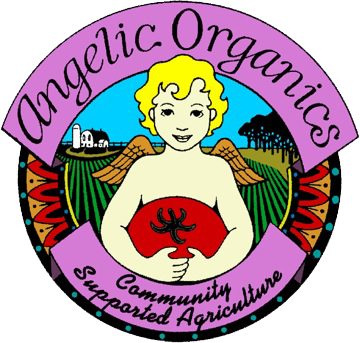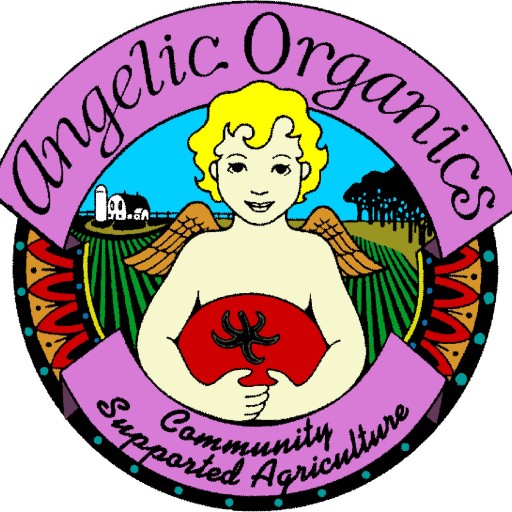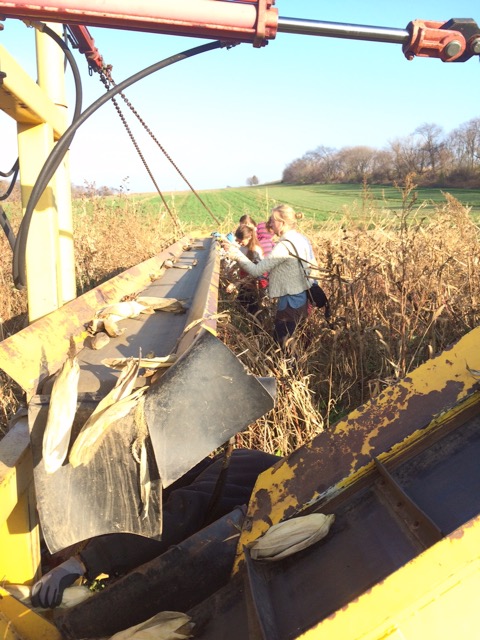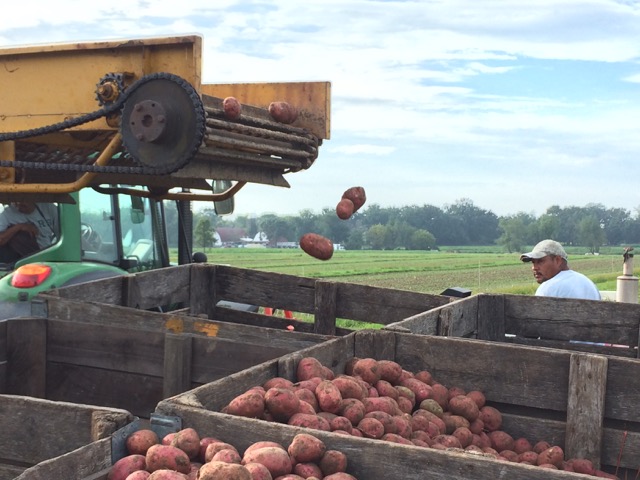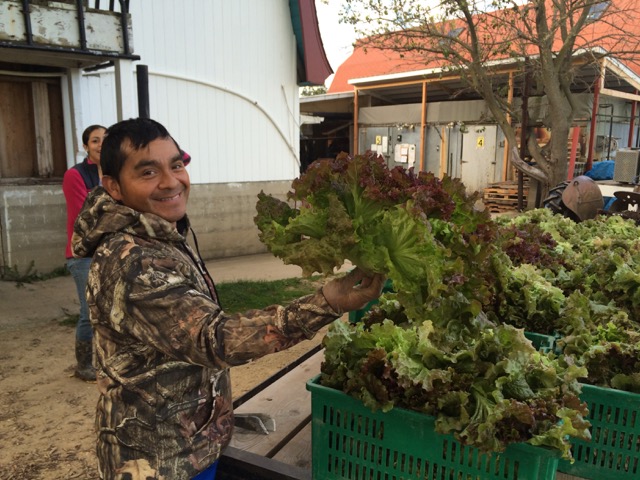Farmer John Writes: What Shareholders Write
Welcome to our Twenty-Third Harvest Week, the Third Week of the Extended Season
Please Flatten Your Boxes Properly and Return Them, Especially if You have been Stockpiling Them
Please return your empty, flattened vegetable boxes to your delivery site. If you receive home delivery, place your box(es) in the location where your box is delivered. If you receive fruit, you’ll need to re-cycle your fruit box on your own, as the farm does not re-use your fruit boxes.
If this week is your last week to pick up, it would be great if you not only return all your empty vegetable boxes, but also transfer this week’s box contents to your own bag/box at your site. Please be mindful, if you do this transfer, that you don’t create a mess for your host to clean up.
Upcoming Treats this Week and Next
We like to snaz the boxes up a bit just before Thanksgiving. We harvested our popcorn. There will be popcorn in both this week’s box and the final box. It might be dry enough when you receive it to pop right away, or you might need to husk the ear and let it dry on your counter for a while.
Popcorn Harvest Last Week
There will also be German White Porcelain garlic in this week’s and next week’s box. Some of you will receive a bulb; some will receive a bag of large, lovely cloves. I was a bit fooled by the garlic this year. We had tremendous amounts of rain while the garlic was maturing. I thought this would delay the maturation of the garlic and also the drying of the wrappers that enclose the bulb. It seems the rain actually accelerated the maturation of the garlic, including the drying of the wrappers. It makes no sense when I write this, but such are the mysteries of farming. The result is that some of the garlic bulbs have wrappers that have somewhat disintegrated. The garlic is still good, but the bulbs are not as picturesque as in a regular year. Many shareholders have told me that our garlic is the best they’ve ever eaten. That’s a nice thing to be told.
Sorry, No More Winter Squash
Several shareholders have written wondering if they will be getting more winter squash. I have mentioned numerous times in my Farm News column that we had a disappointing squash crop this year. Also, I knew the squash we did harvest was not going to keep well, because of the early defoliation of the squash vines, due to the wet season. We have now had three unusually wet summers in a row. Some of our crops do not do well in humid conditions, notably cucurbits, which include winter squash, zucchini and cucumbers—they get leaf blight and they mature prematurely. I do my best to inform our shareholders of these challenges and shortfalls. If a shareholder does not read the newsletter (thank you for reading it today), then it’s impossible to keep the shareholder in touch with the intricacies of production and the composition of the box. (Since we had a small squash crop that ripened somewhat early this year, I would also like to note that we were blessed with an abundance of other crops that compensated for this shortfall.)
Sometimes I elaborate on a crop or a condition, so as to really highlight the thought, care and planning that goes into providing you with food, so here goes… Winter squash is one of my favorite crops to grow. It grows splendidly in hot, dry summer weather (which we have not experienced now for several seasons.) Our spaghetti and butternut squash comprised about 1/3 of our whole squash crop—they yielded very well. Our red kuri, pie pumpkins, and baby blue hubbard comprised another third or so of our squash crop—they yielded about 1/2 to 1/3 of what they should have, due to the leaf blight. This made for an overall disappointing squash crop.
Next year, I’m going to change up the very carefully choreographed crop rotation schedule, so as to have the winter squash follow our solanaceous crops of tomatoes, peppers, and eggplant. The reason I am able to do that next year is that we took advantage of the early dieback of tomatoes (leaf blight again) and put compost on these fields and seeded cover crops there—it is a very unusual feat to get cover crops in after these fields are finished in the fall.
I will now take this a little further, just to convey the considerations that go into just a single crop. Winter squash is usually transplanted (yes, we transplant it, to make sure there will be a good stand) in early June, just before we start harvesting for the CSA. Sometimes, we are able to get cover crops (peas) into the ground in March, but usually it is mid to late April before we can get them in. To properly prepare a field for transplanting, the cover crop typically needs to be tilled in 10 days to 2 weeks before planting. So, the peas would need to be incorporated into the soil by around May 20. That’s not much of a window to get a cover crop established—from late April to mid-May. It’s only about every 5th year or so that I feel it is even worth our while to seed a spring cover crop into the ground where winter squash will be planted, because we have to get the cover crop in by mid-April for it to provide much fertility before winter squash is planted. We will hustle next spring to finesse a pea crop into the squash fields, but, again, it is often folly to try. So, fortunately, we seeded a cover crop this year where the squash will go next year, but it’s not a very well established cover crop. It’s small, because it had to go in late—it had to wait until the peppers, tomatoes and eggplant were finished. There was a narrow window then for getting the pea crop in and growing. So, I’ll also try to get a cover crop in next spring before squash planting. I could go on for several hundred more words about our methods for growing winter squash, but I’ll restrain myself, as I’m not trying to provide a tutorial for growing winter squash; I’m simply striving to perform my role as your farmer in conveying to you how we do our utmost to bring you great crops.
I’m not writing all of this so you will learn how to grow winter squash; I just want you to know we go to great lengths to get the very best crops possible, and sometimes we don’t succeed. I take the setback especially personally with winter squash, because I love growing winter squash. I love watching it grow. I love the color and shapes of the squash. I love how they look on the harvest wagons and when being placed in your box. I am probably the saddest of all that the winter squash was a mediocre crop this year. But, I am also relieved that we had a bounty of other crops to put into your box.
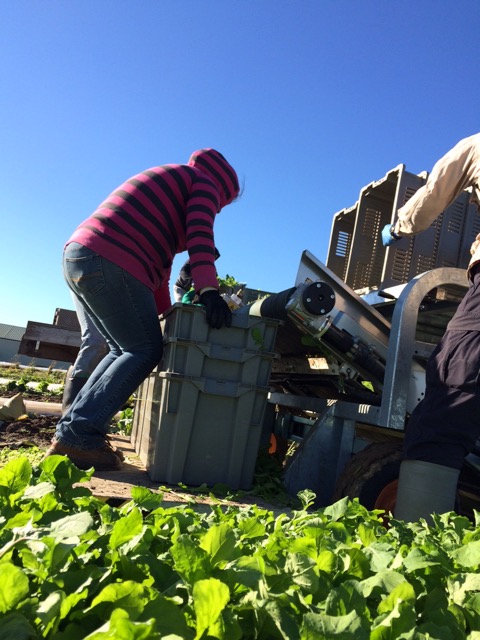
The arugula came on strong at the end of the season. It will have some nuanced flavors, due to its affinity for cold temperatures
Shareholders Write (Nice that so many shareholders write us with joy and gratitude…)
“I can’t thank everyone at Angelic Organics enough! … simply for the fact that I have eaten from your bountiful, delicious harvest for probably 15 years now and you have taught me what is important in my diet. You give me radish greens and fresh dill, and parsnips and kale along with colorful and tasty potatoes. These are just a few of the foods that you surprise me with, and now I enjoy them! Sorry to see the deliveries end soon. Rosemarie”
“Dear Angelic Growers: Many thanks for a wonderful season of great veggies!! I looked forward to getting my “gift” of beautiful, delicious produce every other week and was never disappointed (well, the turnips, maybe). Please know how much I appreciate the hard work and dedication and love and patience that goes into growing these crops. I have already signed up for next year and look forward to being just as pleased. Have a safe, healthy winter and spring!! Fondest regards, Sharon”
“Dear Shelly,
Thanks to you and all those who make Angelic Organics what a great CSA. Tell Farmer John the surprises are part of the fun since it would be much more boring if we knew what to expect in each box. Sincerely, Sara”
“Hi, Also, thanks for the DAIKON this week! Some people at our drop off location apparently don’t like it, so SCORE for us. We traded our dill and one head of lettuce for two gigantic daikon radishes, and my Indian mother in law (who cooks most of our food (from your boxes)) thought we hit the lottery. It is a mere 12 hours after we picked it all up, and it is totally gone. She made stuffed paranthas. So delicious!”
Yet another competitor for the CSA model?
Grow Your Own! Grove Ecosystem – Grow Fresh Food In Your Home. Soon there will be a kit available that enables you to grow your own food inside your home—with no soil and LED grow lights. The LED lights are automated to mimic the sun—seems like a bold claim. Hmm…Honey, let’s sit under this LED light to catch some rays.
They are running a crowdfunding campaign:
http://www.businessinsider.com/grove-lets-you-grow-food-at-home-2015-11
Angelic Organics catchline is Your Very Own Farm—Without all the Work! The Grove Ecosystem catchline could be Your Very Own Cabinet Farm—With all the Work. At least, the Grove Ecosystem food is not being produced by a 3D printer.
Let us Know
Let Shelly know anything you’d like to share about this week’s box email hidden; JavaScript is required. Please note the week and day of delivery, your site, when you picked up your box, and any comments about your box.
More from Shareholders
Visit us often at www.facebook.com/angelicorganics, where we post exciting farm developments regularly, and shareholders post recipes, tips, and photos.
Saturday’s Box Contents
Please Note: this summary is written before you receive your box—be aware that some guesswork is involved. What we think we’ll put in your box might not actually end up in your box. As always, be sure to thoroughly wash all of your vegetables, and remember to sort through your baby greens to eliminate any discolored leaves or weeds.
Salad Greens – lettuce, arugula
Fruiting Crops – popcorn
Cooking Greens – kale tops
Brassicas – Brussels sprouts
Alliums – garlic, onions
Root Crops – beets, potatoes
Thank you for being with us this year,
Farmer John and the Crew
Holiday Gifts from your Very Own Farm, December 5 from 9am-12pm, Angelic Organics Learning Center
Instead of cruising Amazon or visiting a big box store, consider a trip to the farm for our DIY Holiday Gifts class. You’ll create lovely, unique, handmade gifts with ingredients from your very own farm: lip balm, calendula salve, goat’s milk soap and bath salts. You’ll make six of each to give as gifts to friends and family. It’s on Saturday, December 5 from 9am-12pm. Pre-register on our website: http://www.learngrowconnect.org/event/diy-holiday-gifts
